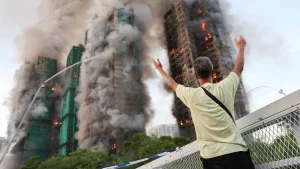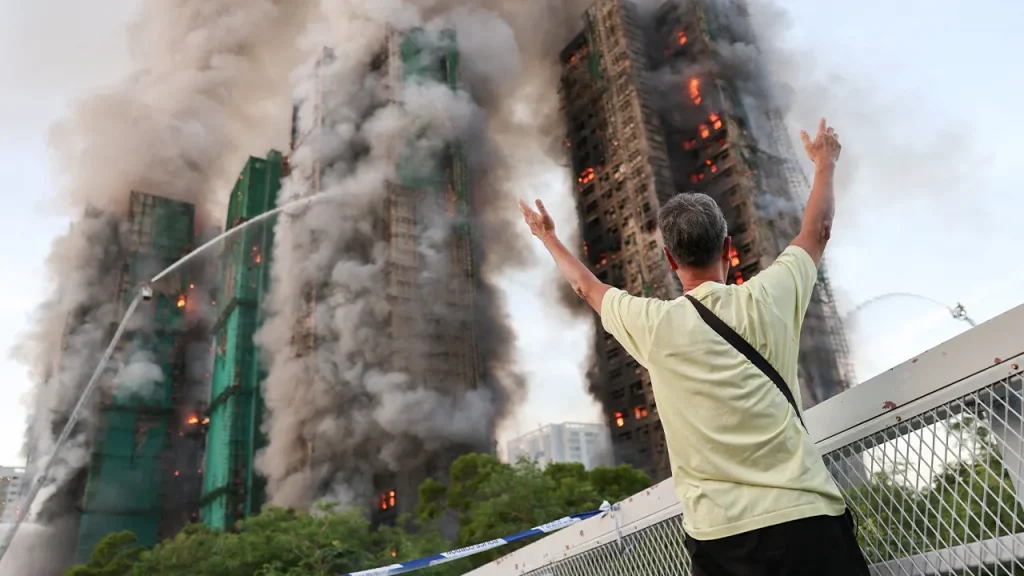Tragic Fire Engulfs Hong Kong High-Rises: A Community in Mourning
In a devastating turn of events on Wednesday, a massive fire swept through several high-rise residential towers in Hong Kong’s Tai Po district, claiming at least thirteen lives and leaving residents and emergency responders in shock. The Hong Kong Fire Services Department received initial reports of the blaze at Wang Fuk Court around 2:50 p.m., but within hours, the situation had escalated dramatically. By early evening, officials had raised the alarm to a No. 5—the most severe rating in Hong Kong’s emergency classification system—indicating the extraordinary danger and complexity of the fire. The tragedy has not only devastated families but also claimed the life of a firefighter who perished while attempting to save others, prompting Hong Kong Security Secretary Tang Ping-keung to express profound grief: “I am profoundly grieved at the passing of Mr. Ho, who lost his life in the course of an operation. I offer my deepest condolences to his family members.” The human toll of this disaster extended beyond those who lost their lives, with multiple people hospitalized in critical or serious condition.
The horrifying scene unfolded as bamboo scaffolding surrounding the towers became engulfed in flames, creating a terrifying spectacle of fire climbing the buildings’ exteriors while thick, dark smoke poured from multiple floors. Eyewitnesses described heart-wrenching moments as desperate residents sought safety and worried about loved ones still trapped inside. One man was photographed in visible distress, crying out that his wife remained trapped in the burning building. First responders worked frantically to battle the inferno while simultaneously conducting search and rescue operations in increasingly dangerous conditions. The rapidly spreading flames created a nightmare scenario for both residents and firefighters, with multiple floors affected simultaneously. The bamboo scaffolding, commonly used in Hong Kong construction and renovation projects, appears to have contributed to the fire’s rapid spread, creating additional challenges for firefighters attempting to contain the blaze.
Perhaps most troubling in the aftermath of the disaster are reports from residents that fire alarm systems apparently failed during this critical emergency. Chan Kwong-tak, an 83-year-old retiree living in the community, told The South China Morning Post that despite the buildings being equipped with alarm systems, they did not activate when the fire broke out. “If someone was sleeping then, they were done,” he remarked, highlighting the potentially fatal consequences of such a failure. Former district councillor Herman Yiu Kwan-ho corroborated these accounts, noting that residents reported not hearing any fire alarms even after they detected smoke. According to Yiu, many residents were only warned when a security guard knocked on their doors, giving them precious little time to evacuate. These alarming reports raise serious questions about building safety standards and emergency preparedness in the residential complex.
The human impact of this tragedy extends far beyond statistics. Nine people were rushed to local hospitals—the Alice Ho Miu Ling Nethersole Hospital and the Prince of Wales Hospital—where medical teams worked desperately to save lives. Four victims were pronounced dead upon arrival, while others fought for their lives with three listed in critical condition, one serious, and another stable. Behind each of these clinical descriptions lies a human story: families torn apart, lives changed forever, and a community left to grapple with an immense loss. The death of a firefighter in the line of duty adds another layer of tragedy to the disaster, highlighting the extreme risks emergency responders take to protect the public. Mr. Ho, the fallen firefighter, represents the ultimate sacrifice made by those who rush toward danger while others flee from it.
The response to the crisis extended beyond immediate firefighting efforts. The Tai Po District Office quickly opened temporary shelters at the Kwong Fuk Community Hall and the Tung Cheong Street Community Hall to provide safe haven for displaced residents. These emergency accommodations became vital gathering points for those who had lost their homes or were temporarily unable to return to them due to fire damage. The community response demonstrated the resilience and solidarity that often emerges during times of crisis, with neighbors helping neighbors and government services mobilizing rapidly to address immediate needs. However, for many affected residents, the trauma of this event will linger long after the flames are extinguished, requiring ongoing support and assistance as they work to rebuild their lives and homes.
This catastrophic fire at Wang Fuk Court raises critical questions about building safety standards, emergency response protocols, and residential infrastructure maintenance in Hong Kong. The apparent failure of fire alarm systems, if confirmed, points to potentially serious oversights in safety management that must be addressed to prevent similar tragedies in the future. As the community mourns its losses and supports the injured, attention will inevitably turn to understanding exactly how this disaster occurred and what steps can be taken to enhance the safety of high-rise residential buildings. The images of flames consuming the scaffolding and the stories of residents narrowly escaping with their lives serve as stark reminders of the vulnerabilities that can exist even in modern urban environments. For the residents of Wang Fuk Court and the broader Tai Po community, the process of healing, investigating, and rebuilding now begins amid the grief of lives lost and forever changed by this tragic fire.















